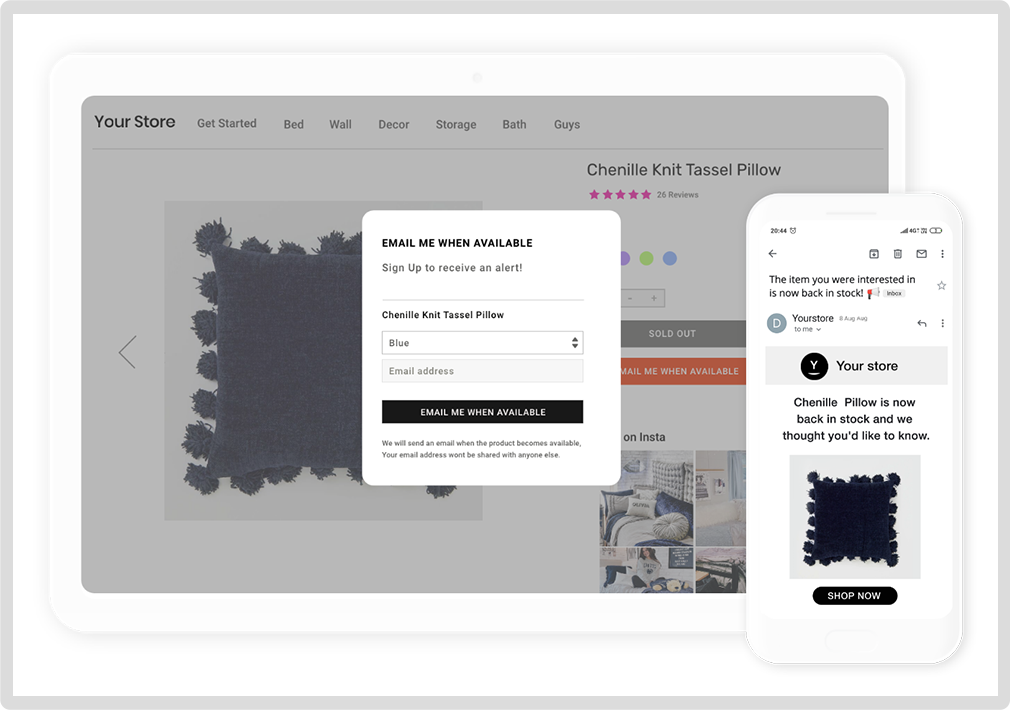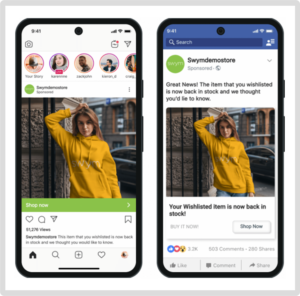Retargeting and remarketing sound fairly similar, and each should have a reserved spot in your cache of marketing moves for your e-commerce store. However, there are several distinctions between the concepts, and you’ll need to acknowledge these if you intend to maximize the outcomes that both concepts potentially bring to the table.
In a nutshell, here’s how they’re different: A retargeting strategy is about reeling in prospects who have yet to make any purchases at your store, while a re-marketing strategy is about re-engaging your current customers.
Retargeting might mean sending a discount code to a customer who visited your store, added items to a cart, and then left your site without making a purchase. On the other hand, remarketing might look something like an email reminder or email subscription discount offer to a customer who has ordered your shaving cream at least once.
In this blog, we’ll dive deeper into the retargeting and remarketing strategies that we’ve described above, pinpoint use cases, and look at strategies for putting both concepts into practice. By the end, you will be ready to retarget and remarket to reap the best outcomes. If you’re an e-commerce marketer looking to drive increased personalization to your advertising and marketing efforts, this article is for you.
Retargeting and remarketing 101: Definitions, distinctions, and similarities
A retargeting strategy is a calculated, targeted, personalized response to potential customer’s behavior and actions on your website that have not yet resulted in a purchase. They may spend time browsing specific products, product categories, or collections, or even take more concrete actions: they may add items to a cart, wishlist items, or sign up for back-in-stock notifications if they like a product that’s no longer available.
All of these actions are markers of expressed interest. When you capitalize on said interest by driving FOMO with a customized low-stock alert or a back-in-stock alert, or break down pricing and other barriers to purchase with an irresistible discount offer, you’re retargeting.
A remarketing strategy is also a calculated, targeted and personalized, but your actions target existing customers, who have already made a purchase. The rest is pretty much the same as retargeting: You use your customer’s purchase behavior to upsell, cross-sell, build loyalty with subscriptions or rekindle a relationship with your customer.
As you would have noticed from our descriptions thus far, remarketing and retargeting strategies share common ground. They’re both anchored in personalization, and in doing so move away from the more generic forms of advertising that marketers used in the past. Traditional, offline advertising forms like television and print ads, hoardings and radio spots gave marketers far less opportunity to personalize campaigns, but online advertising, apps that collect data on your website (and the data footprint left by smartphone users who spend a lot of time on social media, where you’re still allowed to collect data) have made this deep personalization possible today.
Use cases: How context guides prioritization of one strategy over the other
Since you’re always going to have interested prospects and existing customers, you’re never going to either retarget or remarket. However, you will retarget in some cases and remarket in other cases.
When to play your retargeting strategy card:
🌟 When your main aim is customer acquisition
🏠 If your product is a one-time (or one-time in a long time) buy like, if you sell
consumer durables like refrigerators and ACs
🎯You need to support your existing brand awareness campaigns with targeted marketing for customers who are showing a degree of interest
💸You’re seeing a lot of traffic on your site that isn’t converting, and you do have sufficient margin to offer more competitive pricing by way of limited validity discount codes
When to play your remarketing strategy card:
🤝When your main aim is customer loyalty
🔄If product bodes well for repeat purchases (examples include nutritional supplements, stationary, personal care, and grooming essentials, grocery items and pet food)
💸When you have budget constraints, and consequently need to make only safe bets with your advertising capital
🩹In situations where you may have experienced quality complaints, resulting in customers not returning, but you’ve since fixed things and intend to re-ignite trust and relationships
It’s showtime! Run retargeting and remarketing strategies that convert with these initiatives
Part I – Retargeting campaign ideas every e-commerce marketer must try
Retarget browsers and fans/ almost-fans who have not made a purchase with emails, SMS messages, or push notifications:
This retargeting strategy is for shoppers who have visited your website and spent time poring over product. Maybe they even showed affirmative purchase intent by adding an item to their cart or their wishlist.
If you are using Swym Wishlist Plus, you can retarget users who have wishlisted items thanks to wishlist data. Wishlist Plus does two things: it first encourages a customer who’s been hovering on a page for a whole to add a product to their wishlist with a Wishlist Nudge that goes something like:
Find out more about Wishlist Nudges here.
Next, you can remind shoppers about items in their wishlist using Wishlist Plus’ automated reminders. If you have already installed Wishlist Plus for your e-commerce store, these quick steps will allow you to set up automated Wishlist email reminders. Customers would receive an email with an image of the product, reminding them to return to the store and complete their purchase. Like this:
This is an example of retargeting because the brand is targeting a customer’s existing interest in a product
Of course, a reminder may not be tempting enough for some shoppers, especially if the barrier is price, or if they simply do not need the item immediately. In such cases, low-stock alerts, price-drop alerts, and even back-in-stock alerts might cinch the deal for you.
Thinking about how to get started with this? We’ve got your back. Dedicated resources on leveraging Swym data for automatically triggered email marketing via integrations with Klaviyo and Omnisend are available here. We’ve created and curated these resources just for e-commerce marketers in mind, and you’ll get dedicated step-by-step playbooks for wishlist reminder emails, wishlist back-in-stock alerts and wishlist price drop alerts.
Retarget browsers and fans/ almost-fans who have not made a purchase with personalized Meta ads
You can also use wishlist data to serve an ad for a product that a customer has wishlisted to them on their social media feed. Imagine the wishlisted hoodies in the marketing email above showing up as your customer is going through other posts and stories on Instagram, for instance. Under this retargeting strategy, your ads would look something like this:
This could be an example of remarketing where you’re attempting to draw past customers back into the store
This resource will help you to design Meta ad campaigns using your Swym Back-In-Stock data.
Retarget browsers and fans/ almost-fans who have not made a purchase with a personalized customer accounts page
Your once-interested customer might also return to your store one day for countless reasons. Maybe they’re bored and stopped by to window-shop. Or perhaps they’ve come by to browse for a gift or some other specific item. Whatever their reasons are, you want them to be greeted by the items they liked the last time they were here. Items they wishlisted, requested to be notified about, or viewed in detail.
When you have Swym tools like Wishlist Plus and Back-In-Stock Alerts, you gain access to a buffet of analytics and insights that allow you to customize your customer accounts page and run this strategic retargeting move like a pro.
Part II – Remarketing campaign ideas every e-commerce marketer must try
Remarketing with personalized product recommendation emails
This strategic remarketing move means cross-selling, up-selling, encouraging repeat (or repetitive, via subscription) purchases and similar moves. For example, if a customer purchases a pair of dress shoes, you might showcase associated attire and accessories.
As you can see, the remarketing strategy is very similar to what you might do in a retargeting campaign. However, instead of targeting a prospect, you’re targeting an existing customer, increasing your chances of conversion, especially if the customer was pleased with their prior purchase(s).
Remarketing with personalized ads on Meta platforms
You can also try a similar remarketing strategy by targeting existing customers on Facebook and Instagram. You might, for example, have a carousel ad showcasing the pair of dress shoes, from the example above, with various attire and accessory combinations. Maybe even a discount code that goes like MISSYOU20 for 20% off, or some such.
Remarketing with a tailor-made customer accounts page
The personalization ideas for your customer accounts page that we suggested under retargeting represent the tip of the iceberg when it comes to customizing your customer accounts page — once your customer has made a purchase, or several, there’s a whole bag of tricks you can use.
You can add restock buttons next to products they frequently order in the order history view of the customer accounts page. You could mention rewards and loyalty points earned and even place special discounts here. We have a whole blog with ideas on how you can elevate your customer accounts page — read it here.
You can also read our marketing director’s blog on remarketing strategy to get ideas on how to get your remarketing campaign right.
Never forget that data is the driving force behind both, retargeting, and remarketing strategies
With all the tips, inspiration, and ideas in this blog, you should be able to select a remarketing strategy or remarketing strategy and run your campaign with full confidence. Before you get started, however, be sure to line up, and strengthen your customer data sources. These analytical insights fuel both strategies with the critical personalization that gets a prospect or customer’s attention. With that, you’re ready to retarget and remarket to reap conversions like never before.





